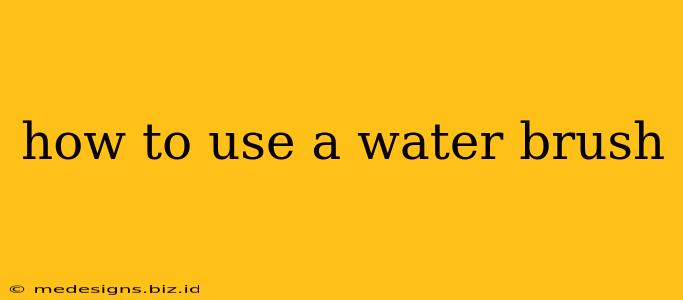Water brushes are revolutionizing watercolor painting, offering convenience and control that traditional brushes can't match. But if you're new to them, mastering their quirks can feel a little daunting. This comprehensive guide will walk you through everything you need to know, from choosing the right brush to creating stunning watercolor effects.
Understanding Your Water Brush
Before diving into techniques, let's understand what makes a water brush unique. Unlike traditional brushes that require a separate water source, water brushes have a built-in reservoir. This reservoir holds water, which is then released to the brush tip as you paint. This allows for seamless blending and effortless transitions between colors.
Key Features of a Water Brush:
- Internal Reservoir: This is the heart of the water brush, holding the water supply.
- Brush Tip: The tip’s shape and size determine the brushstrokes you can achieve; from fine lines to broad washes. Many offer replaceable tips!
- Control Mechanism: Most have a button or mechanism to regulate the water flow. Mastering this is key to consistent results.
Choosing the Right Water Brush
The market offers a wide variety of water brushes, each with unique features. Consider these factors when making your choice:
- Tip Shape: Round tips are versatile for detail work and fine lines, while flat tips are ideal for broader strokes and washes.
- Tip Size: Select a size appropriate for your painting style and desired level of detail. Experiment with different sizes to find your preferences.
- Reservoir Capacity: Larger reservoirs require less refilling but might make the brush feel heavier. Smaller reservoirs are more lightweight but require more frequent refills.
- Brand and Quality: While more expensive brushes might offer better longevity and performance, entry-level options offer excellent value.
Getting Started: Your First Water Brush Painting
Let's learn the basics. You'll need your water brush, watercolor paints, and watercolor paper (cold-pressed is recommended for beginners).
1. Filling the Reservoir:
This step is simple! Unscrew the cap and fill the reservoir with clean water. Don't overfill, as this can lead to leaks.
2. Controlling the Water Flow:
Practice controlling the water flow by gently squeezing the barrel. Start with a light squeeze for delicate lines and increase the pressure for bolder strokes. Experiment to find the sweet spot for your preferred water release.
3. Loading the Brush with Paint:
Dip the brush tip into your watercolor paint. Don't overload it; a small amount of paint is sufficient.
4. Applying the Paint:
Practice different brush strokes—light strokes, heavy strokes, dots, lines, and washes. Experiment with pressure to vary the intensity of color and the thickness of lines.
5. Cleaning Your Brush:
After using your water brush, rinse it thoroughly with clean water to prevent the paint from drying and clogging the brush. You can also periodically flush out the reservoir with clean water to ensure optimal performance.
Advanced Techniques with a Water Brush
Once you've mastered the basics, explore these advanced techniques:
- Blending: Seamlessly blend colors by layering washes and varying the amount of water.
- Layering: Gradually building up color intensity by applying several thin layers of paint.
- Lifting Techniques: Use a dry brush or a clean damp brush to lift off paint, creating subtle effects and textures.
- Wet-on-Wet vs Wet-on-Dry: Experiment with applying water-brush paint to both wet and dry paper to achieve different effects.
Troubleshooting Common Water Brush Problems
- Leaks: Check for cracks or damage to the barrel. Ensure you are not overfilling the reservoir.
- Clogged Tip: Rinse the brush thoroughly and use a pin or needle to clear any blockage.
- Uneven Water Flow: Try cleaning the brush thoroughly and ensure there's no debris inside the reservoir.
Conclusion: Embrace the Convenience and Control
Water brushes offer incredible convenience and control for watercolor painting. By understanding their features, choosing the right brush, and mastering basic techniques, you can unlock a world of creative possibilities. So grab your water brush, pick up your paints, and start creating beautiful watercolor art!
